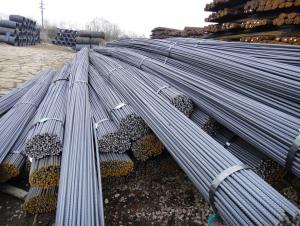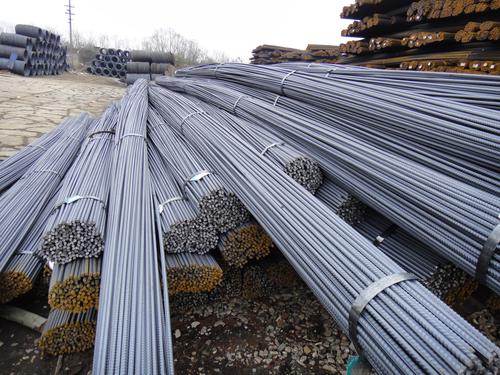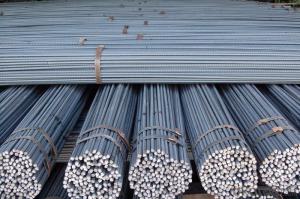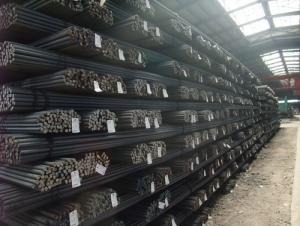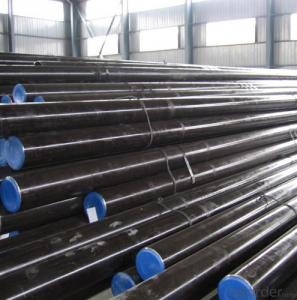High grade hot rolled bar
- Loading Port:
- China Main Port
- Payment Terms:
- TT OR LC
- Min Order Qty:
- -
- Supply Capability:
- -
OKorder Service Pledge
OKorder Financial Service
You Might Also Like
Reinforcing bar (Rebar) refers to the use of reinforced concrete and prestressed concrete with steel, its cross section is round, sometimes for the square with rounded corners. Including light round bar, ribbed steel bar, torsion bar. Reinforced concrete with steel bar is refers to the reinforced concrete reinforcement with straight or plate of strip steel, its appearance is divided into two kinds, light round steel and deformed steel delivery status for the straight bar and wire rod in two. Light round bar is really a small round steel and ordinary low carbon steel wire rod. Deformation is surface ribbed steel bar, usually with 2 longitudinal and cross rib of uniform distribution along the length direction. The appearance of cross rib is spiral, chevron, crescent 3 kinds. With nominal diameter mm number representation. Equals the nominal diameter is equal to the cross section deformation of reinforced light round bar nominal diameter. Reinforcement of nominal diameter is 8-50 mm, recommends to the diameter of 8, 12, 16, 20, 25, 32 and 40 mm. Steel grade: 20 mnsi, 20 mnsi MNV, 25, BS20MnSi. Rebar in concrete main tensile stress. Deformed bars as a result of the action of rib, and concrete have larger bonding ability, thus better able to withstand the role of external force. Steel is widely used in various building structures. Especially large, heavy, light thin wall and high-rise building structure.
Steel processing, steel processing to table and design review, check the material list for errors and omissions, for each steel bar to press
Material list to check whether meet the requirements, after these two checks, then press the material list sent out samples, trial production of qualified rear can batch production, processing and good reinforcement to neatly stacked in order.
Construction such as the need to be reinforced by substitution, must fully understand the design intent and substitution material performance, strictly abide by the current design code of reinforced concrete rules, not to area such as the substitution of low strength of high strength steel reinforcement. Any important parts of a reinforced substitution, shall agree with the consent of party a, design unit, and have a written notice shall be substitution.
(1) the steel surface should be clean, sticky oil, dirt, rust must be cleaned before use, can be combined with cold-drawn rust removal process.
(2) reinforced straightening, usable mechanical or manual straightening. After straightening of steel can not have local small bending, die bending, wavy, its surface scars should not be made of steel decreases by 5%.
(3) the steel bar cutting should be according to the number, diameter, length and quantity, the length is tie-in, first cutting long expected, by cutting short expected to reduce short head, and shorten the steel to save steel.
(4) steel hook or bend:
1) steel hook. There are three kinds of forms, respectively semicircle hook, hook and hook. After bending, bend endothelial contraction, skin
Extension, axis length is constant, bend arc formation, size is greater than the baiting size after bending, bending modifier should be considered.
Reinforced bending diameter of 2.5 d heart, straight part for 3 d. Steel hook increase the length of the theoretical calculation value: counter rotating round hook is 6.25 d, the straight
Hook is 3.5 d, the hook is 4.9 d.
(2) the bending of steel. Middle bending diameter D bend, not less than five times the diameter of the reinforcing steel bar.
(3) the stirrup. Stirrups should be done at the end of the hook, hook form should meet the design requirements. Stirrup adjustment, is the hook to increase the length and bending adjustment
Value or the difference between the two and, according to the amount of stirrup outsourcing size or inside the package size.
(4) reinforced blanking length should be according to the component size, concrete cover thickness, rebar bend modifier and hook to increase the length of the provisions as comprehensive exam
Lv.
A. straight reinforced blanking length = member length - protective layer thickness increase length + hook,
B. turn up steel blanking length = straight length - bend modifier + + inclined curved length increase length of hook,
C. blanking length = stirrup stirrup inner perimeter + modifier + hook to increase length of stirrup.
- Q: Can steel rebars be used in foundations and footings?
- Yes, steel rebars can be used in foundations and footings. Steel rebars are commonly used to reinforce concrete structures, including foundations and footings, to provide added strength and stability. They help to prevent cracking and increase the structural integrity of the foundation or footing.
- Q: What are the different methods of reinforcing concrete structures using steel rebars?
- There are several methods of reinforcing concrete structures using steel rebars. 1. Traditional Reinforcement: This method involves placing steel rebars in the formwork before pouring concrete. The rebars are positioned in a predetermined pattern and secured with wire or tie rods to ensure they stay in place during the concrete placement. This method is commonly used for reinforcing columns, beams, and slabs. 2. Pre-stressed Reinforcement: In this method, high-strength steel rebars are pre-stressed before being placed in the concrete structure. This is usually achieved by stretching the rebars and then anchoring them to resist the tensile forces that will be exerted on the structure. Pre-stressed reinforcement is commonly used in bridges and large-span structures where high strength and durability are required. 3. Post-tensioning: Post-tensioning is a technique used to reinforce concrete structures after the concrete has hardened. It involves inserting steel tendons into pre-determined ducts or sleeves within the concrete and then applying tension to the tendons using hydraulic jacks. This process helps to counteract the tensile forces and increase the overall strength and load-carrying capacity of the structure. 4. Fiber Reinforcement: Instead of using traditional steel rebars, fiber reinforcement involves adding small fibers made of materials like glass, polypropylene, or steel to the concrete mix. These fibers help to distribute and control cracks that may occur due to shrinkage or thermal expansion. Fiber reinforcement is often used in applications such as industrial flooring, shotcrete, and precast concrete products. 5. Reinforced Concrete Masonry: In this method, steel rebars are inserted into the mortar joints of concrete masonry units (CMUs) to increase the strength and stability of the structure. The rebars are placed vertically and horizontally at specific intervals and then grouted to ensure a solid bond between the rebars and the CMUs. Overall, these different methods of reinforcing concrete structures using steel rebars provide various options for engineers and designers to enhance the strength, durability, and load-carrying capacity of concrete structures, depending on the specific requirements of the project.
- Q: How do steel rebars prevent concrete from cracking?
- Steel rebars prevent concrete from cracking by providing reinforcement and increasing its strength. When concrete is poured, it is initially in a liquid state and lacks tensile strength, meaning it is prone to cracking under tension. However, steel rebars are embedded within the concrete structure, forming a strong bond with the concrete as it hardens. The rebars act as a framework within the concrete, distributing the tensile forces evenly throughout the structure. When external forces, such as load or temperature changes, act on the concrete, the rebars resist the tensile stresses that would otherwise cause cracks to form. This is because steel has a much higher tensile strength compared to concrete. Moreover, steel rebars also help to control cracks that may occur due to shrinkage during the curing process of concrete. As the concrete dries and hardens, it undergoes a chemical reaction that causes it to shrink. This shrinkage can lead to cracks, but the presence of rebars restrains the concrete from expanding or contracting excessively, reducing the likelihood of cracking. In addition to preventing cracks, steel rebars also enhance the overall structural integrity of the concrete. They help to distribute the load evenly, making the concrete structure more resistant to bending, shearing, and other forces. This reinforcement ensures that the concrete can withstand the anticipated loads and maintain its stability over time. Overall, steel rebars play a crucial role in preventing concrete from cracking by providing tensile strength and reinforcement. By distributing tensile forces, controlling shrinkage, and enhancing structural integrity, they ensure that the concrete remains strong, durable, and resistant to cracking, thereby prolonging its lifespan and ensuring its stability.
- Q: What is the difference between steel rebars and FRP rebars?
- Construction projects use steel rebars and FRP rebars as reinforcement materials, but they differ in composition and mechanical properties. Steel rebars, made of carbon steel, are known for their strength and durability, making them a reliable choice for reinforcing concrete structures. On the other hand, FRP rebars are composed of fibers embedded in a polymer matrix, such as glass or carbon. This composite material offers advantages over steel rebars. Firstly, FRP rebars are lighter, making them easier to handle and transport, reducing labor and equipment costs. Secondly, FRP rebars do not corrode, unlike steel rebars. Steel rebars are prone to corrosion when exposed to moisture and chemicals, weakening the structure over time. FRP rebars, however, are resistant to rust and corrosion, making them ideal for environments with high humidity, saltwater, or chemical exposure. Additionally, FRP rebars have a high resistance to electromagnetic fields, making them suitable for sensitive areas like hospitals, power plants, or telecommunication facilities, where minimizing electromagnetic interference is crucial. However, FRP rebars have lower tensile strength compared to steel rebars, making them less suitable for heavy-load-bearing structures. Moreover, FRP rebars initially cost more than steel rebars, but their long-term durability and reduced maintenance requirements can offset this expense. In conclusion, the differences between steel rebars and FRP rebars lie in their composition, mechanical properties, and performance in various environmental conditions. Steel rebars offer high tensile strength but are susceptible to corrosion, while FRP rebars are lighter, non-corrosive, and have a high resistance to electromagnetic fields. The choice between the two depends on project requirements, load-bearing needs, and environmental factors.
- Q: How do steel rebars affect the overall crack width of concrete structures?
- Steel rebars can significantly reduce the overall crack width of concrete structures. By reinforcing the concrete, rebars help distribute and resist tensile forces, preventing cracks from widening or forming in the first place. This reinforcement enhances the structural integrity and durability of the concrete, ensuring it can withstand external loads and environmental factors.
- Q: What are the different coating options available for steel rebars?
- There are several coating options available for steel rebars, including epoxy, zinc, and polyethylene. Epoxy coating provides corrosion resistance and is commonly used in harsh environments. Zinc coating, such as hot-dip galvanizing, offers excellent protection against corrosion and is often used in marine applications. Polyethylene coating provides a barrier against moisture and chemicals, making it suitable for applications where corrosion resistance is a priority.
- Q: How do steel rebars affect the overall cost of maintenance in a structure?
- Steel rebars can have a significant impact on the overall cost of maintenance in a structure. The use of steel rebars enhances the structural integrity and durability of the building, reducing the risk of structural failures and minimizing maintenance requirements. Steel rebars help to reinforce the concrete, making the structure more resistant to cracks, corrosion, and other forms of damage. By preventing or delaying these issues, the overall cost of maintenance, repairs, and replacements is reduced over the lifespan of the structure.
- Q: What are the safety precautions when handling steel rebars?
- When handling steel rebars, it is important to follow several safety precautions. Firstly, always wear appropriate personal protective equipment (PPE) such as gloves, goggles, and steel-toed boots to protect yourself from potential injuries. Secondly, ensure that the work area is clear of any debris or obstacles that may cause trips or falls. Additionally, use proper lifting techniques and team lifting when necessary to avoid strain or back injuries. It is crucial to be aware of the weight and length of the rebars being handled to prevent them from falling or causing accidents. Lastly, remember to store and stack the rebars securely to prevent them from toppling over and causing injuries.
- Q: How are steel rebars manufactured?
- Steel rebars are manufactured through a process called hot rolling, where steel billets are heated and passed through a series of rollers to shape them into the desired size and form. The rebars are then cut to the required lengths and undergo further processes like quenching and tempering to enhance their strength and durability.
- Q: What is the role of steel rebars in preventing concrete cracking?
- The reinforcement of concrete structures is greatly aided by the use of steel rebars. These rebars are essential in preventing cracks from forming in the concrete and in improving its overall durability and strength. Concrete has a tendency to crack when subjected to tensile stress due to its low tensile strength. However, when steel rebars are embedded within the concrete, they act as a reinforcement by absorbing and dispersing these tensile forces throughout the structure. The inclusion of steel rebars in concrete is effective in counteracting the natural inclination of concrete to crack under tension. When a load is applied to the concrete, the rebars bear a significant portion of the tensile stress, preventing it from being concentrated solely on the concrete itself. This distribution of forces helps minimize the development and spread of cracks, ensuring the structural integrity of the concrete. Furthermore, steel rebars also contribute to the overall strength and durability of concrete structures. The combination of steel's high tensile strength and concrete's compressive strength results in reinforced concrete, which provides exceptional resistance against various external forces, such as bending, shear, and seismic loads. This additional strength makes the concrete less prone to cracking and enhances its ability to withstand heavy loads and environmental factors over time. In conclusion, steel rebars play a critical role in preventing concrete cracking by providing reinforcement, absorbing and dispersing tensile forces, and improving the overall strength and durability of concrete structures. Their presence greatly enhances the structural integrity and longevity of concrete, making it a dependable and extensively used construction material.
Send your message to us
High grade hot rolled bar
- Loading Port:
- China Main Port
- Payment Terms:
- TT OR LC
- Min Order Qty:
- -
- Supply Capability:
- -
OKorder Service Pledge
OKorder Financial Service
Similar products
Hot products
Hot Searches
Related keywords
